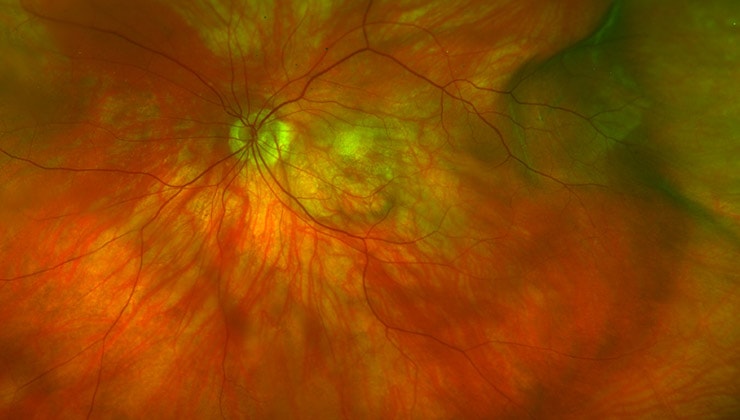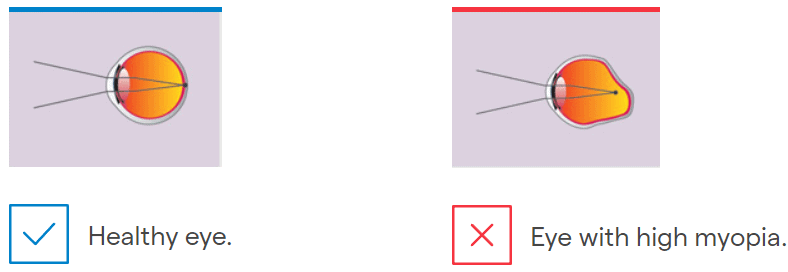
What is high myopia?
Myopia is a refractive defect or error in visual focusing. Images are focused in front of the retina and not on it, making long distance vision difficult. When the visual error exceeds eight dioptres, it is referred to as high myopia. High myopia affects about 2% of the population and results in a greater predisposition to suffer from certain eye disorders. These disorders include:
- Retinal detachment
- Degeneration of the central retina caused by atrophic patches
- Growth of blood vessels beneath the retina in the macular area
- Myopic macular hole
- Separation of the layers of the macular retina (schisis)
These conditions can cause significant visual disability and directly affect the quality of life of patients, especially when they are of working age.
What causes it?

It occurs when the eyeball is elongated or the cornea is more curved than usual. People with a family history of the disease are more likely to suffer from it.
How can it be prevented?
It is not possible to prevent myopia, but regular eye check-ups can facilitate early diagnosis and treatment of associated complications.
Symptoms
A myopic person sees objects clearly if they are close up, but blurred if they are at a distance.
Patients with high myopia often complain of seeing wavy lines or opaque spots in their field of vision and a loss of visual acuity.
Patients with high myopia require regular eye examinations to check for damage to the retina since, in many cases, symptoms are not evident.
Associated treatments
Unlike those who have mild myopia, patients with high myopia are usually discouraged from having laser surgery on the surface or internal layers of the cornea.
Specialists who treat this pathology
FAQs
Angiography is a technique used to delineate retinal or choroidal cases. Different contrasts are used, usually sodium fluorescein or indocyanine green. The scan is also useful for the diagnosis of other retinal diseases, such as pigment epithelium. In general, angiography is used to study many retinal diseases and their diagnosis.
Indocyanine green angiography is a technique used in some cases of AMD and serves to define the neovessels and, occasionally, to diagnose other diseases. Fluorescein angiography is the standard technique for studying blood vessel diseases and the retina in general.
It is a diagnostic technique to determine pathological and abnormal structures in the blood vessels and the different layers of the retina. It can be used in cases of macular degeneration, diabetic retinopathy, vasculopathy and many other macular disorders.
It is not counterproductive for any eye treatment.
Yes, after any eye operation, although it is advisable to wait several days for the scars to heal. It normally takes ten to twelve days to return to a normal life. It is always best to consult the doctor to find out about the risk factors.
In general, the patient can lead a normal life, unless there is gas inside the eye, in which case the patient should heed the advice of his doctor. Flying above 600–800 m and travelling over high mountain passes, either by train or car, should be avoided. If such needs arise, the ophthalmologist should be consulted.
IMO Institute of Ocular Microsurgery
Josep María Lladó, 3
08035 Barcelona
Phone: (+34) 934 000 700
E-mail: international@imo.es
See map on Google Maps
By car
GPS navigator coordinates:
41º 24’ 38” N – 02º 07’ 29” E
Exit 7 of the Ronda de Dalt (mountain side). The clinic has a car park with more than 200 parking spaces.
By bus
Autobus H2: Rotonda de Bellesguard, parada 1540
Autobus 196: Josep Maria Lladó-Bellesguard, parada 3191
Autobuses H2, 123, 196: Ronda de Dalt – Bellesguard, parada 0071
How to arrive at IMO from:
IMO Madrid
C/ Valle de Pinares Llanos, 3
28035 Madrid
Phone: (+34) 910 783 783
See map in Google Maps
Public transport
Metro Lacoma (líne 7)
Autobuses:
- Lines 49 & 64, stop “Senda del Infante”
- Line N21, stop “Metro Lacoma”
Timetables
Patient care:
Monday to Friday, 8 a.m. to 9 p.m.
IMO Andorra
Av. de les Nacions Unides, 17
AD700 Escaldes-Engordany, Andorra
Phone: (+376) 688 55 44
See map in Google Maps
IMO Manresa
C/ Carrasco i Formiguera, 33 (Baixos)
08242 – Manresa
Tel: (+34) 938 749 160
See map in Google Maps
Public transport
FGC. Line R5 & R50 direction Manresa. Station/Stop: Baixador de Manresa
Timetables
Monday to Friday, 09:00 A.M – 07:00 PM













